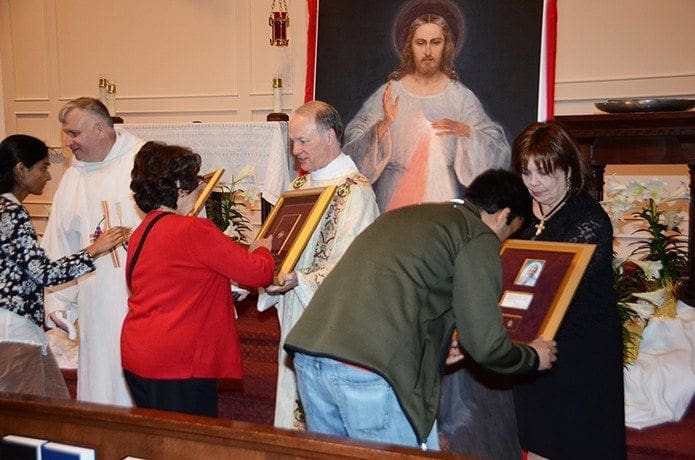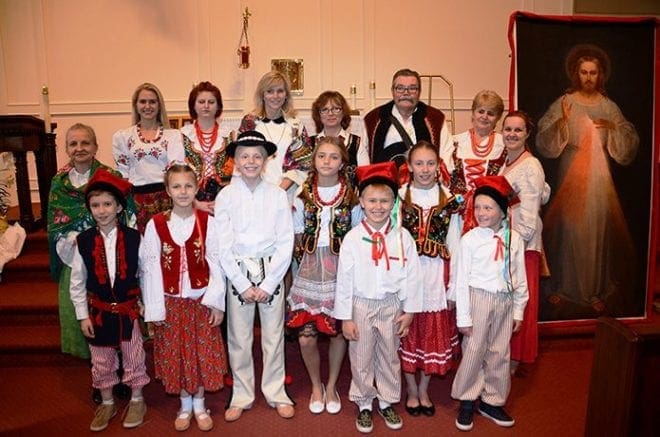 Photo By Agnieszka Sulewska
Photo By Agnieszka Sulewska Lawrenceville
Divine Mercy Sunday marked with bilingual Mass, veneration of relics
By JEAN DRISKELL, Special to the Bulletin | Published April 14, 2016
LAWRENCEVILLE—The Polish community of St. Marguerite d’Youville Church, along with other members of the parish and the archdiocese, celebrated Divine Mercy Sunday April 3 with Mass, the Divine Mercy chaplet, veneration of relics of St. John Paul II, St. Faustina and Blessed Mother Teresa, and a documentary on the history of the original image of the Divine Mercy.
Children and adults of the Polish community in regional native costumes led the procession into Mass. American, Polish and papal flags were carried in, followed by the relics, the icon of Our Lady of Czestochowa (The Black Madonna) and the large replica of the original image of the Divine Mercy.
The Mass was celebrated in Polish and English by Father Wieslaw Berdowicz, SCh. Deacon Gerald Zukauckas, who leads a Divine Mercy apostolate at the Cathedral of Christ the King, served at the Mass and his wife, Sharon, was a lector.
After the celebrant gave a homily in Polish, Deacon Albert Feliu followed with a homily in English.
Deacon Feliu said the real source of love is Jesus’ mercy. In today’s world with murder, terrorism, suicide, we ask where is God, he said. To show us, God gave us two saints, St. Faustina and St. John Paul II.
“They fought back with God’s mercy,” he said.
“Jesus says come to me, I am Mercy itself,” Deacon Feliu said. “Pope John Paul II knew God’s mercy. He said, ‘Do not be afraid.’ That is what this beautiful image is all about: Do not be afraid. If so, you can’t experience mercy.”
“We need to say I’m sorry and you’re forgiven—to God, to us, and to each other,” he said.
Deacon Feliu also said when feeling low and that God does not love you, reject that thought as it is not so. “Say, I’m sorry and God will wrap his arms around you and forgive you,” he said.
Polish families alternate bringing icon, chalice home
At the offertory, the chalice was brought up in a clear glass container with the other gifts.
“We have a tradition where a different family, every Sunday, brings the icon of Our Lady of Czestochowa and the chalice, in its glass container, home for veneration and prayers for the vocations to the priesthood,” said Anna Oberc, a member of the St. John Paul II Polish Apostolate.
“The chalice is protected. It is like a relic because it contained the Blood of Christ,” she said. “This is a very nice tradition. It started with Father Piotr Nowacki, Polish priest at St. Marguerite d’Youville in 2011, at the time St. Pope John Paul II’s relic came to the Polish Apostolate.”

Children and adults of the Polish community attended the Divine Mercy Sunday Mass at St. Marguerite d’Youville Church, Lawrenceville, in regional native costumes. During the Mass they led the procession. The Divine Mercy image is shown to the right. Photo By Agnieszka Sulewska
After the Mass, the Divine Mercy chaplet was sung in English led by cantor Ewa Dorhmi, who also was the soloist for the Mass. Janusz Komor accompanied her on the organ.
Following the chaplet the congregation had the chance to venerate the first-class relic of St. John Paul II, which was given to the Polish Apostolate at the time of the pope’s beatification in May 2011. They were the first to be given this relic outside of Rome and Poland. Also venerated were first-class relics of St. Faustina and second-class relics of Blessed Mother Teresa, which belong to St. Marguerite d’Youville Church.
Following the veneration, documentary director Daniel diSilva presented his film, “The Original Image of the Divine Mercy.”
“I heard a small piece on the history of the original Divine Image and it inspired me,” diSilva said. “I knew no one knew the story. In January 2015 I started making the documentary on the research of the original Divine Mercy image.”
Before the saint’s vision of Jesus as the Divine Mercy, “there had not been a Divine Mercy image,” he said.
“There are many images of the Divine Mercy made after St. Faustina’s vision. But only the original image was the one she saw,” he said.
“There had to be an original Divine Mercy painting, the one St. Faustina writes about in her diary.”
DiSilva said that the movie is being offered to churches, schools and organizations during the Jubilee Year of Mercy. The DVD will be available in November.
“Jesus is luminous … blocking the darkness”
“I love the Mass. We celebrated as one big family today,” Oberc said. “Many nationalities were present. I hope many people from the other churches will have the same experiences as I did and will bring the movie to their parishes and save many hearts to Jesus.”
Oberc and Dorhmi, along with Gienia Klas, parishioners of St. Marguerite d’Youville and members of the Polish Apostolate, attended the Divine Mercy Lenten retreat at the Cathedral March 12. DiSilva presented the documentary there and the women agreed this movie needed to be shared at St. Marguerite d’Youville.
Oberc said she went to Father Jim Harrison, pastor of St. Marguerite d’Youville, and to Father Berdowicz to ask if they could bring the movie and have a Divine Mercy celebration on Divine Mercy Sunday.
“Father Jim said the church is yours,” Oberc said, “and Father Wieslaw also gave me permission.”
“The way he (diSilva) spoke on the Divine Mercy image,” Oberc said, “his testimony, and the fact that I saw this movie, I felt the internal need to show this movie to as many people as possible.”
Oberc, along with Deacon Zukauckas and his wife, coordinated the celebration for Divine Mercy Sunday at both St. Marguerite d’Youville and later that evening at the Cathedral.
Gregg Brodka, from St. Marguerite d’Youville, provided the projection equipment.
“I always appreciate the Mass. It is the closest I could get to experiencing a Polish Mass outside of Poland,” he said.
The Polish native moved to the United States when he was 16. He became an American citizen and served in the military with honors.
“The homily is very profound,” said Pearl Jacob, a Cathedral parishioner. “Especially when he said the message of the Divine Mercy image is not to be afraid, Pope John Paul’s words, and the words, at the bottom of the image, ‘Jesus, I trust in You.’ This says we are not to be afraid of God and his Son in spite all the darkness in the world. With the dark background, Jesus … is luminous, blocking the darkness.”
“The Mass was very good, beautiful. It was well-organized,” Helena Wojdyla said.
“Beautiful Mass, beautiful people. We like to sing the Divine Mercy chaplet,” Wladyslaw Wojdyla said.
A trailer of the documentary can be viewed at www.divinemercyfilm.com.